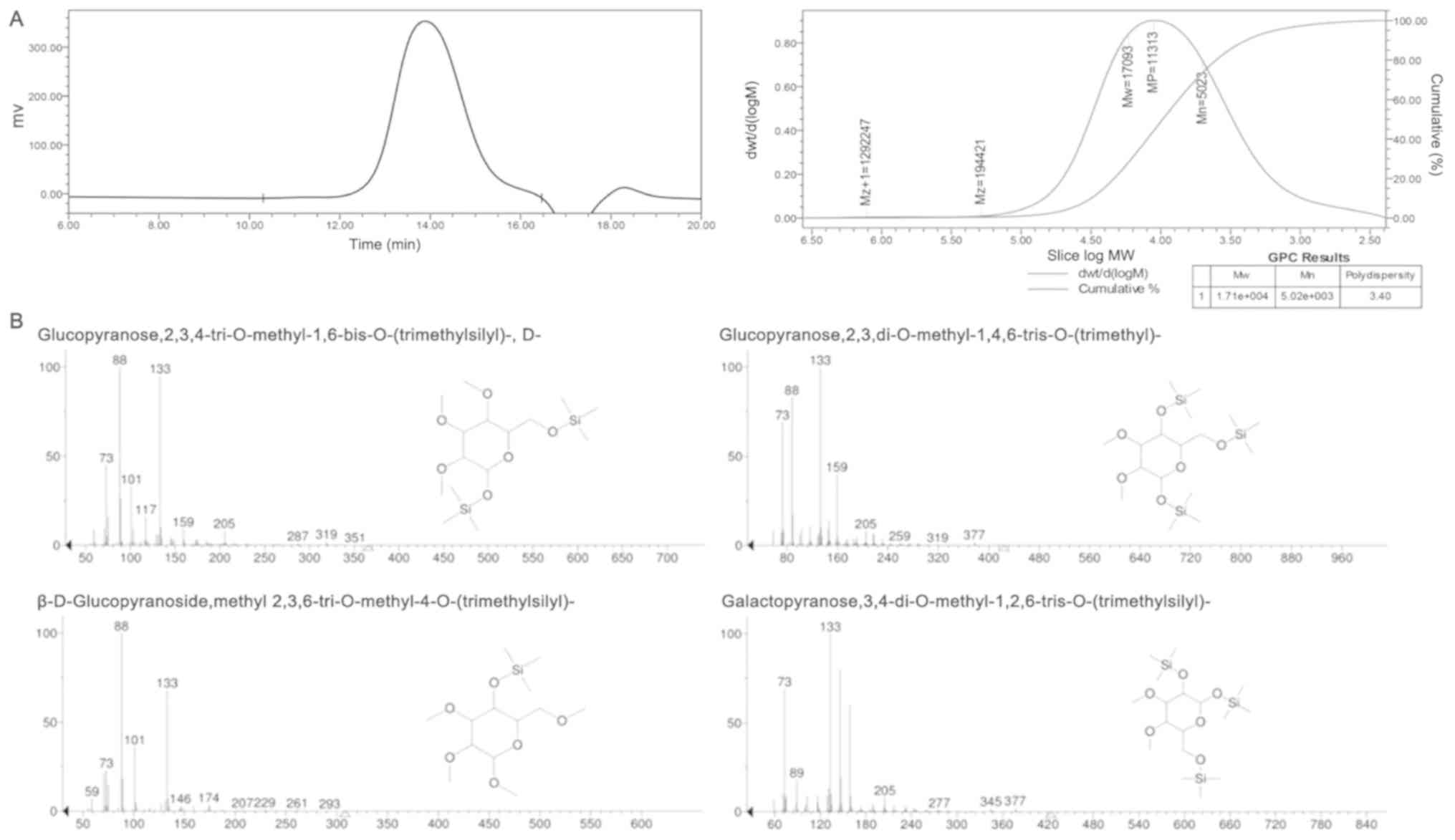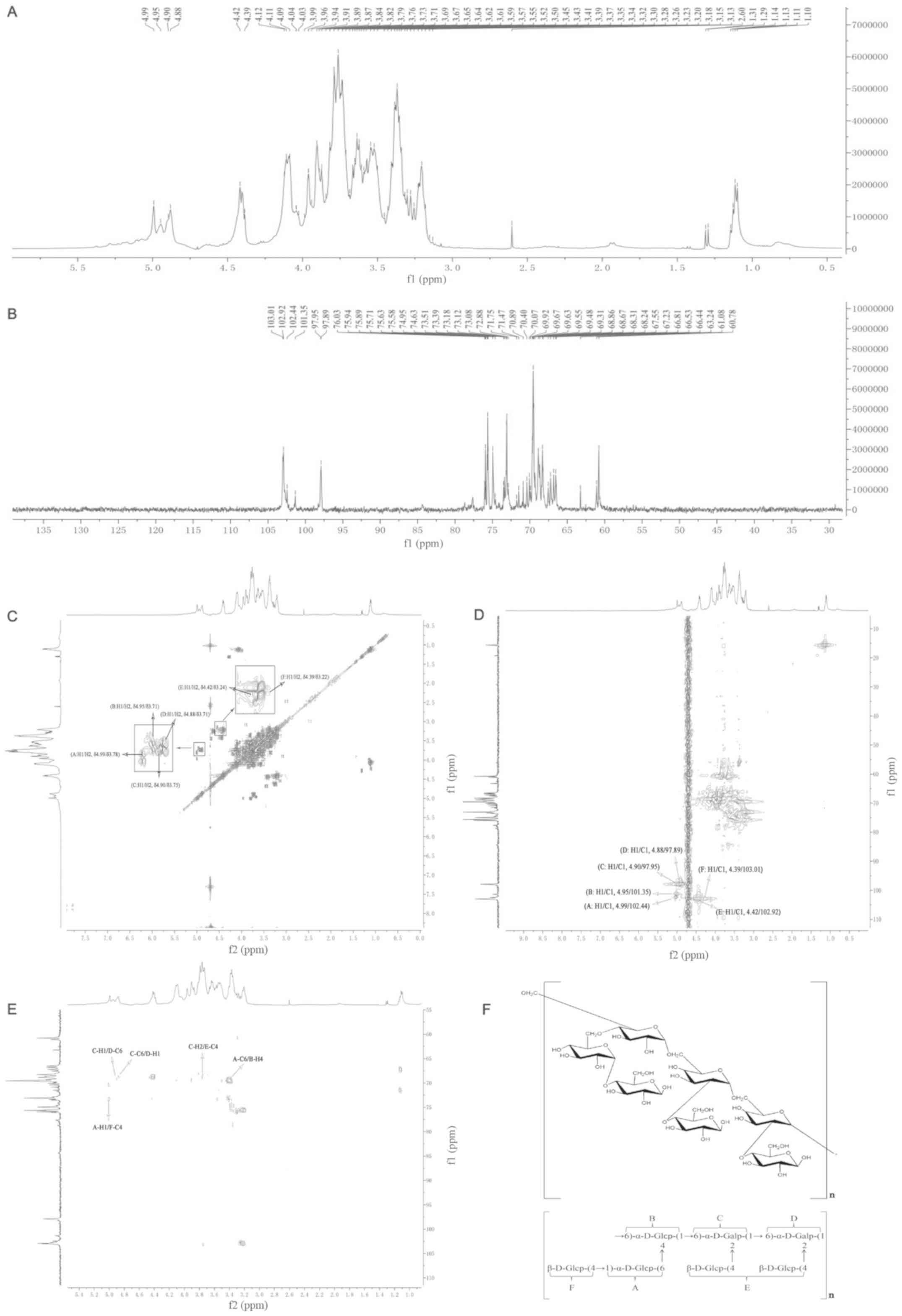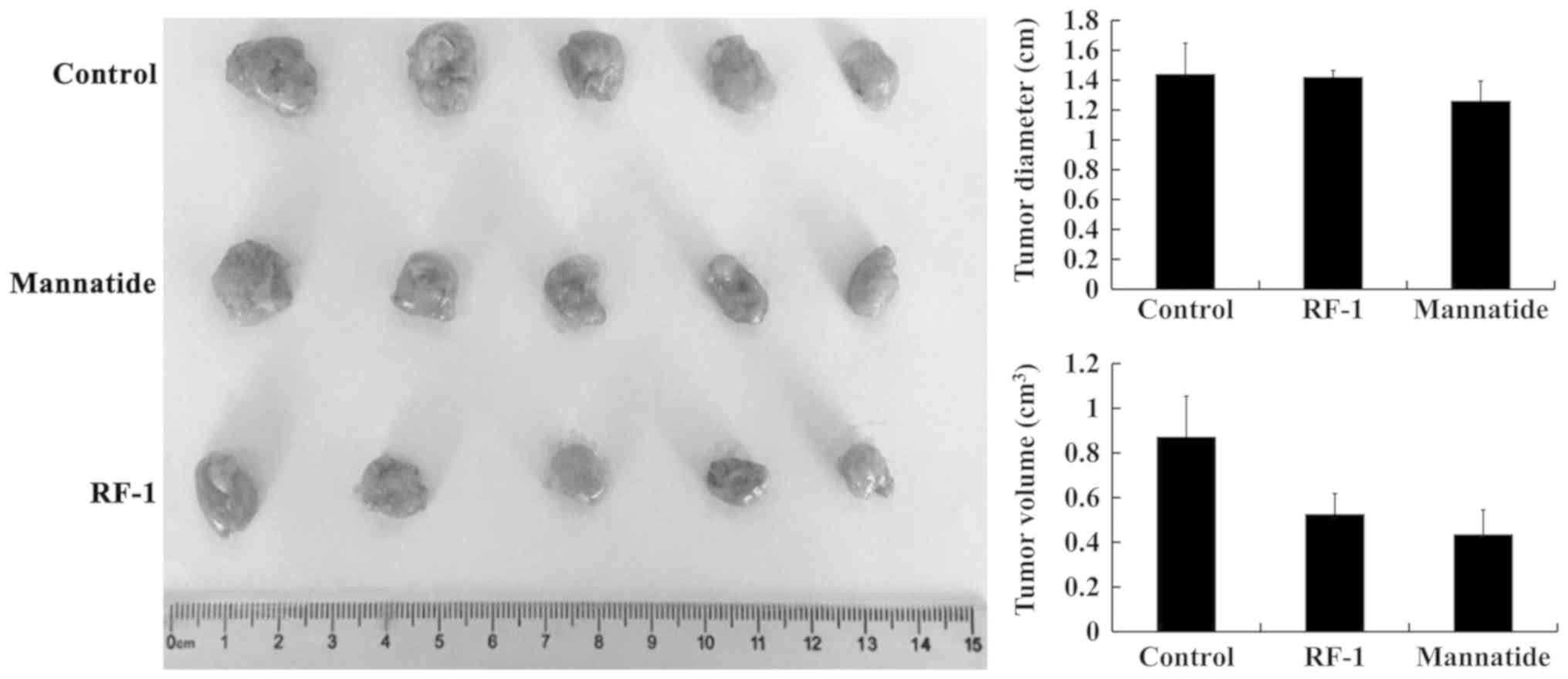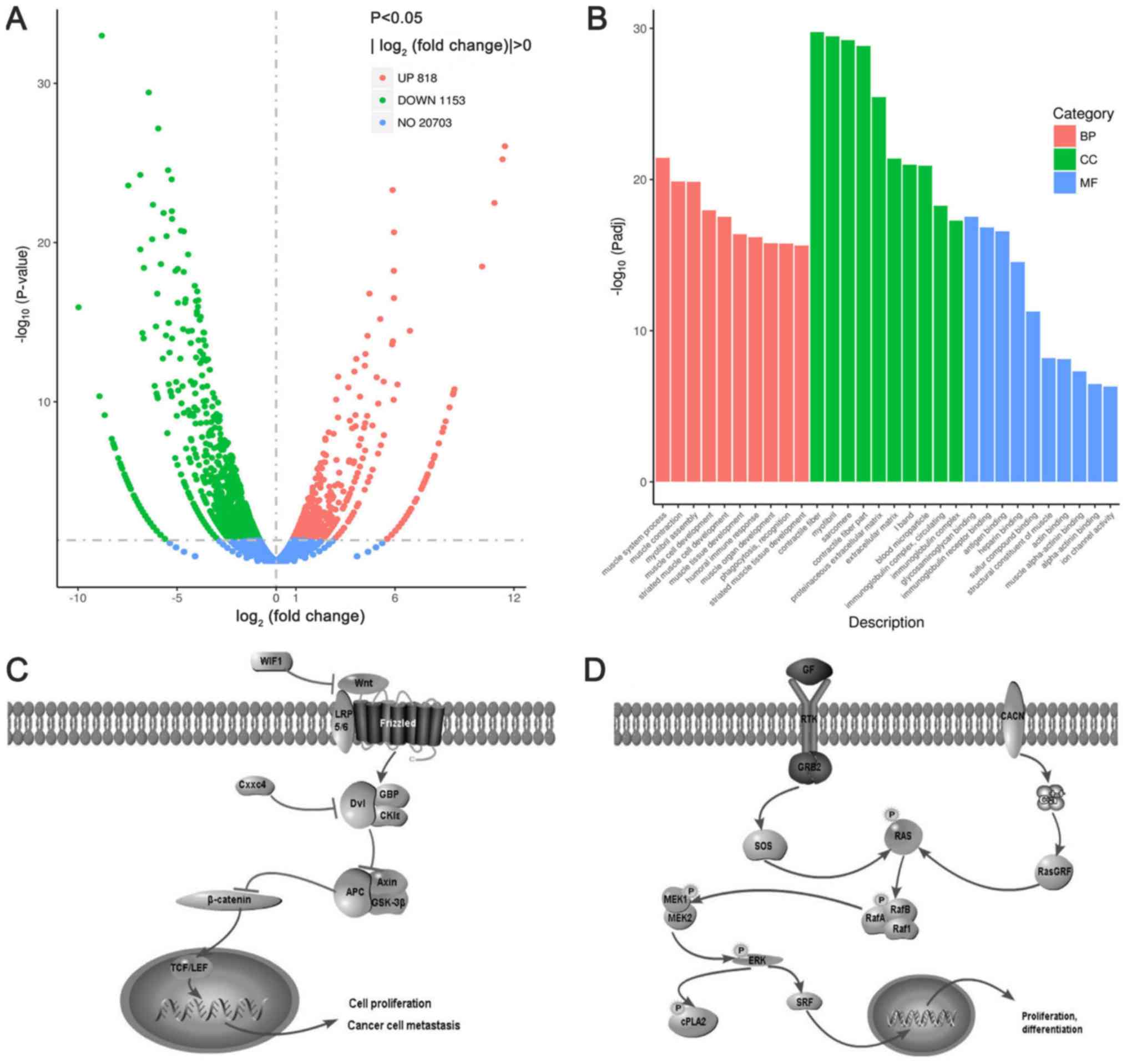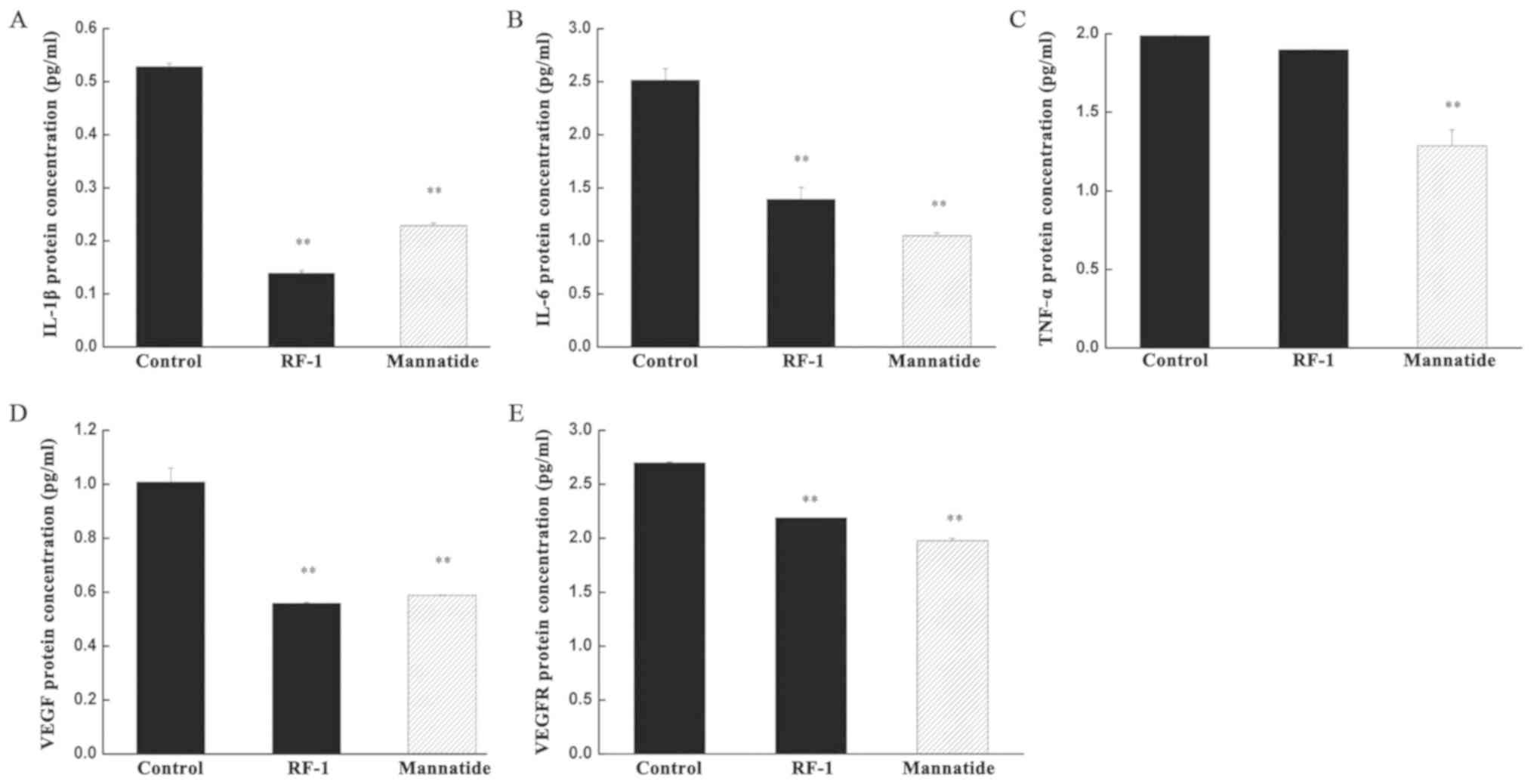|
1
|
Yang H, Guo S and Sagitov A: The
collection and separation of the special edible and medicinal
mushrooms in china and Kazakhstan and efficacy evaluation. Sci Tech
Infor Dev Economy. 23:132–136. 2013.
|
|
2
|
Zheng L, Chen XQ and Cheong KL: Current
trends in marine algae polysaccharides: The digestive tract,
microbial catabolism, and prebiotic potential. Int J Biol Macromol.
151:344–354. 2020. View Article : Google Scholar : PubMed/NCBI
|
|
3
|
Liu L, Cui Y, Pi F, Cheng Y, Guo Y and
Qian H: Extraction, purification, structural characteristics,
biological activities and pharmacological applications of
acemannan, a polysaccharide from aloe Vera: A review. Molecules.
24:15542019. View Article : Google Scholar
|
|
4
|
Ding X, Hou YL and Hou WR: Structure
feature and antitumor activity of a novel polysaccharide isolated
from Lactarius deliciosus Gray. Carbohydr Polym. 89:397–402. 2012.
View Article : Google Scholar : PubMed/NCBI
|
|
5
|
Yu Y, Shen MY, Song QQ and Xie JH:
Biological activities and pharmaceutical applications of
polysaccharide from natural resources: A review. Carbohydr Polym.
183:91–101. 2018. View Article : Google Scholar : PubMed/NCBI
|
|
6
|
Chen Q, Cao M, Xiang WL, Sun Q, Zhang J,
Hou RT, Yan ZY, Yang ZR, Liu J and Zhao J: Study on genes with
altered expression in alpha-amanitin poisoned mice and evaluation
antagonistic effects of traditional Chinese medicines against its
toxicity. Acta Biol Hung. 60:281–291. 2009. View Article : Google Scholar : PubMed/NCBI
|
|
7
|
Hou YL, Liu L, Ding X, Zhao DQ and Hou WR:
Structure elucidation, proliferation effect on macrophage and its
mechanism of a new heteropolysaccharide from Lactarius deliciosus
Gray. Carbohydr Polym. 152:648–657. 2016. View Article : Google Scholar : PubMed/NCBI
|
|
8
|
Zhang X, Aweya JJ, Huang ZX, Kang ZY, Bai
ZH, Li KH, He XT, Liu Y, Chen XQ and Cheong KL: In vitro
fermentation of Gracilaria lemaneiformis sulfated polysaccharides
and its agaro-oligosaccharides by human fecal inocula and its
impact on microbiota. Carbohydr Polym. 234:1158942020. View Article : Google Scholar : PubMed/NCBI
|
|
9
|
Song G and Du Q: Structure
characterization and antitumor activity of an α β-glucan
polysaccharide from auricularia polytricha. Food Res Int.
45:381–387. 2012. View Article : Google Scholar
|
|
10
|
Kumar S and Gautam N: Chemical and
bioactive profiling, and biological activities of coral fungi from
northwestern Himalayas. Sci Rep. 7:465702017. View Article : Google Scholar : PubMed/NCBI
|
|
11
|
Su S, Yang Q and Li C: Parameter
optimization of extraction technology of polysaccharides from
Ramaria flaccida. Nat Prod Res Dev. 23:751–754. 2011.
|
|
12
|
Li H, Dou X and Lu Q: Optimization of
selected parameters affecting the extraction of DPPH
radical-scavenging polysaccharide from Ramaria botrytis fruit
bodies. Acta Edulis Fungi. 19:69–72. 2012.
|
|
13
|
Ruthes AC, Smiderle FR and Iacomini M:
D-glucans from edible mushrooms: A review on the extraction,
purification and chemical characterization approaches. Carbohydr
Polym. 117:753–761. 2015. View Article : Google Scholar : PubMed/NCBI
|
|
14
|
Bin Y, Ying Y, Xuefei W, Yanqing HU,
Linlin F and Dandan L: Optimization of deproteinized process from
echinops latifolius tausch polysaccharide by response surface
methodology. Sci Technol Food Industry. 35:287–291. 2014.
|
|
15
|
Plancot B, Gügi B, Mollet JC,
Loutelier-Bourhis C, Ramasandra GS, Lerouge P, Follet-Gueye ML,
Vicré M, Alfonso C, Nguema-Ona E, et al: Desiccation tolerance in
plants: Structural characterization of the cell wall hemicellulosic
polysaccharides in three Selaginella species. Carbohydr Polym.
208:180–190. 2019. View Article : Google Scholar : PubMed/NCBI
|
|
16
|
Pandya U, Dhuldhaj U and Sahay NS:
Bioactive mushroom polysaccharides as antitumor: An overview. Nat
Prod Res. 33:2668–2680. 2019. View Article : Google Scholar : PubMed/NCBI
|
|
17
|
Mohan M, Achary A, Mani V, Cicinskas E,
Kalitnik AA and Khotimchenko M: Purification and characterization
of fucose-containing sulphated polysaccharides from Sargassum
tenerrimum and their biological activity. J App Phycol. 1:1–13.
2019.
|
|
18
|
Mannino MR and Orecchio S: Polycyclic
aromatic hydrocarbons (PAHs) in indoor dust matter of Palermo
(Italy) area: Extraction, GC-MS analysis, distribution and sources.
Atmospheric Environment. 42:1801–1817. 2008. View Article : Google Scholar
|
|
19
|
Sathivel A, Raghavendran HB, Srinivasan P
and Devaki T: Anti-peroxidative and anti-hyperlipidemic nature of
Ulva lactuca crude polysaccharide on D-Galactosamine induced
hepatitis in rats. Food Chem Toxicol. 46:3262–3267. 2008.
View Article : Google Scholar : PubMed/NCBI
|
|
20
|
Šilhánek J: Comparisons of the most
important chemistry databases-Scifinder program and reaxys database
system. Chemicke Listy. 108:81–106. 2014.
|
|
21
|
Gao B and Yang GZ: Effects of Ganoderma
applanatum polysaccharide on cellular and humoral immunity in
normal and sarcoma 180 transplanted mice. Phytotherapy Res.
5:134–138. 1991. View Article : Google Scholar
|
|
22
|
Duan DP, Dang XQ, Wang KZ, Wang YP, Zhang
H and You WL: The cyclooxygenase-2 inhibitor NS-398 inhibits
proliferation and induces apoptosis in human osteosarcoma cells via
downregulation of the survivin pathway. Oncol Rep. 28:1693–1700.
2012. View Article : Google Scholar : PubMed/NCBI
|
|
23
|
Parkhomchuk D, Borodina T, Amstislavskiy
V, Banaru M, Hallen L, Krobitsch S, Lehrach H and Soldatov A:
Transcriptome analysis by strand-specific sequencing of
complementary DNA. Nucleic Acids Res. 37:e1232009. View Article : Google Scholar : PubMed/NCBI
|
|
24
|
Daehwan K, Ben L and Steven LS: HISAT: A
fast spliced aligner with low memory requirements. Nat Methods.
12:357–360. 2015. View Article : Google Scholar : PubMed/NCBI
|
|
25
|
Trapnell C, Roberts A, Goff L, Pertea G,
Kim D, Kelley DR, Pimentel H, Salzberg SL, Rinn JL and Pachter L:
Differential gene and transcript expression analysis of RNA-seq
experiments with TopHat and Cufflinks. Nat Protoc. 7:562–578. 2012.
View Article : Google Scholar : PubMed/NCBI
|
|
26
|
Anders S and Huber W: Differential
expression analysis for sequence count data. Genome Biol.
11:R1062010. View Article : Google Scholar : PubMed/NCBI
|
|
27
|
Gao X, Wang J and Zhang S: Integrated
bioinformatics analysis of Hub genes and pathways in anaplastic
thyroid carcinomas. Int J Endocrinol. 2019:96513802019. View Article : Google Scholar : PubMed/NCBI
|
|
28
|
Kanehisa M and Goto S: KEGG: Kyoto
encyclopedia of genes and genomes. Nucleic Acids Res. 28:27–30.
2000. View Article : Google Scholar : PubMed/NCBI
|
|
29
|
Robinson MD, McCarthy DJ and Smyth GK:
edgeR: A Bioconductor package for differential expression analysis
of digital gene expression data. Bioinformatics. 26:139–140. 2010.
View Article : Google Scholar : PubMed/NCBI
|
|
30
|
Martineau E, Khantache KE, Pupier M,
Sepulcric P, Akoka S and Giraudeau P: Non-linear effects in
quantitative 2D NMR of polysaccharides: Pitfalls and how to avoid
them. J Pharm Biomed Anal. 108:78–85. 2015. View Article : Google Scholar : PubMed/NCBI
|
|
31
|
Jahanbin K, Abbasian A and Ahang M:
Isolation, purification and structural characterization of a new
water-soluble polysaccharide from Eremurus stenophyllus (boiss.
& buhse) baker roots. Carbohydrate Polymers. 178:386–393.
2017. View Article : Google Scholar : PubMed/NCBI
|
|
32
|
Santos G, Oliveira ES, Pinheiro ADN, da
Costa PM, de Freitas JCC, de Araújo Santos FG, Maia FMM, de Morais
SM and Nunes-Pinheiro DCS: Himatanthus drasticus (Apocynaceae)
latex reduces oxidative stress and modulates CD4+,
CD8+, FoxP3+ and HSP-60+
expressions in Sarcoma 180-bearing mice. J Ethnopharmacol.
220:159–168. 2018. View Article : Google Scholar : PubMed/NCBI
|
|
33
|
David B, Edward H, Nick A, Takeshi K, Udo
O, Simon H, Daniel S, Dietrich L, John A and Hassan AB: A germline
mutation of CDKN2A and a novel RPLP1-C19MC fusion detected in a
rare melanotic neuroectodermal tumor of infancy: A case report. BMC
Cancer. 16:629–639. 2016. View Article : Google Scholar : PubMed/NCBI
|
|
34
|
Derenzini M, Montanaro L and Trerè D:
Ribosome biogenesis and cancer. Acta Histochem. 119:190–197. 2017.
View Article : Google Scholar : PubMed/NCBI
|
|
35
|
Michael GK, Jill AI, Smrithi MP, Alex SC
and Vassie CW: RpL22e, but not RpL22e-like-PA, is SUMOylated and
localizes to the nucleoplasm of Drosophila meiotic spermatocytes.
Nucleus. 4:241–258. 2013. View Article : Google Scholar : PubMed/NCBI
|
|
36
|
Shimomura T, Kawakami M, Tatsumi K, Tanaka
T, Morita-Takemura S, Kirita T and Wanaka A: The role of the Wnt
signaling pathway in upper jaw development of chick embryo. Acta
Histochem Cytochem. 52:19–26. 2019. View Article : Google Scholar : PubMed/NCBI
|
|
37
|
Young BK, Boh-Ram K, Kyungsil Y, Choi EK,
Seo SH, Yeonah L, Min AL, Jung BY, Mi SP and Seung BR: WIF1 can
effectively co-regulate pro-apoptotic activity through the
combination with DKK1. Cell Signal. 26:2562–2572. 2014. View Article : Google Scholar : PubMed/NCBI
|
|
38
|
Li C, Wang Z, Chen S, Zhang J, Qu K and
Liu C: MicroRNA-552 promotes hepatocellular carcinoma progression
by downregulating WIF1. Int J Mol Med. 42:3309–3317.
2018.PubMed/NCBI
|
|
39
|
Kojima T, Shimazui T, Hinotsu S, Joraku A,
Oikawa T, Kawai K, Horie R, Suzuki H, Nagashima R, Yoshikawa K, et
al: Decreased expression of CXXC4 promotes a malignant phenotype in
renal cell carcinoma by activating Wnt signaling. Oncogene.
28:297–305. 2009. View Article : Google Scholar : PubMed/NCBI
|
|
40
|
Chiurillo M: Role of the Wnt/β-catenin
pathway in gastric cancer: An in-depth literature review. World J
Exp Med. 5:84–102. 2015. View Article : Google Scholar : PubMed/NCBI
|
|
41
|
Hino S, Kishida S, Michiue T, Fukui A,
Sakamoto I, Takada S, Asashima M and Kikuchi A: Inhibition of the
Wnt signaling pathway by Idax, a novel Dvl-binding protein. Mol
Cell Biol. 21:330–342. 2001. View Article : Google Scholar : PubMed/NCBI
|
|
42
|
Wissmann C, Wild PJ, Kaiser S, Roepcke S,
Stoehr R, Woenckhaus M, Kristiansen G, Hsieh JC, Hofstaedter F,
Hartmann A, et al: WIF1, a component of the Wnt pathway, is
down-regulated in prostate, breast, lung, and bladder cancer. J
Pathol. 201:204–212. 2003. View Article : Google Scholar : PubMed/NCBI
|
|
43
|
White JJ, Mazzeu JF, Coban-Akdemir Z,
Bayram Y, Bahrambeigi V, Hoischen A, van Bon BWM, Gezdirici A,
Gulec EY, Ramond F, et al: WNT signaling perturbations underlie the
genetic heterogeneity of Robinow syndrome. Am J Hum Genet.
102:27–43. 2018. View Article : Google Scholar : PubMed/NCBI
|
|
44
|
Zhang T, Chen H, Zhou Y, Dong W, Cai H and
Tan W: Cooperation of FGF/MEK/ERK and Wnt/β-catenin pathway
regulators to promote the proliferation and pluripotency of mouse
embryonic stem cells in serum- and feeder-free conditions.
Bioresources Bioprocessing. 6:122019. View Article : Google Scholar
|
|
45
|
Dolphin AC: Calcium channel auxiliary
α-2/δ and β subunits: Trafficking and one step beyond. Nat Rev
Neurosci. 13:542–555. 2012. View Article : Google Scholar : PubMed/NCBI
|
|
46
|
Fernando C, Victoria S, Lorena A, Fredrik
W, Erik S, Christopher JM and Piero C: RasGRF suppresses
Cdc42-mediated tumour cell movement, cytoskeletal dynamics and
transformation. Nat Cell Bio. 13:819–826. 2011. View Article : Google Scholar
|
|
47
|
Elena S, David M, Michela S, Romilde M,
Maria S, Rita G, Andrea M, Silvio T, Lilia A and Marco V: Novel
RasGRF1-derived Tat-fused peptides inhibiting Ras-dependent
proliferation and migration in mouse and human cancer cells.
Biotechnol Adv. 30:233–243. 2012. View Article : Google Scholar : PubMed/NCBI
|
|
48
|
James DC, Lin LL, Ronald WK and Clark JD:
A novel arachidonic acid-selective cytosolic PLA2 contains a
Ca2+-dependent translocation domain with homology to PKC
and GAP. Cell. 65:1043–1051. 1991. View Article : Google Scholar : PubMed/NCBI
|
|
49
|
Faure G, Corringer PJ and Edelman A:
Therapeutic potential of rattlesnake PLA2: Impact in Cystic
Fibrosis. Toxicon. 149:93–94. 2018. View Article : Google Scholar
|
|
50
|
Jaworska J and Janowski T: Expression of
proinflammatory cytokines IL-1β, IL-6 and TNFα in the retained
placenta of mares. Theriogenology. 126:1–7. 2018. View Article : Google Scholar : PubMed/NCBI
|
|
51
|
Rostami H and Gharibzahedi S:
Cellulase-assisted extraction of polysaccharides from Malva
sylvestris: Process optimization and potential functionalities. Int
J Biol Macromol. 101:196–206. 2017. View Article : Google Scholar : PubMed/NCBI
|















